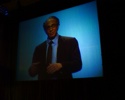Brian Hawkins started by announcing the awards for this year. The new Catalyst award went to Course Management Systems. I thought this was especially interesting considering the controversy around Blackboard and their patent suit. I wonder how much EDUCAUSE had to rework their video script, which said that CMS was something that sprang forth from the academy.
Dennis Trinkle won the EDUCAUSE Quarterly Contribution of the Year award for his article, “The 361 Degree Model for Transforming Teaching and Learning with Technology.” The Leadership Awards went to the late Howard Strauss and Daniel Updegrove.
Ray Kurzweil provided the day’s keynote. His most recent book, The Singularity is Near, is a provoking best-seller.
He’s an alum of MIT, and now serves on their board. He started by talking about how technology is transforming fields like biology. The power of information technologies doubles every year. Specific people and projects are difficult to predict, but trends are easier to predict. Being a successful inventor means being able to predict. Timing is often the reason new technologies fail.
Kurzweil finds that many of the predictions that he made in The Age of Intelligent Machines have come true. He came with several examples of technology today.
Reading machine technology – today’s units are many times smaller. Today the devices are portable, while only years ago they were desk-bound. The National Federation of the Blind asked him in 2002 when the device would be available. He said May 2006. It would take about as long to develop due to the “vagaries of real-world print”. The device was introduced in July. He gave us a demonstration. In less than a minute, the machine had processed a picture of the page and was reading the page to us.
Nice quote: “If you understand something in only one way, then you don’t understand it at all.”
The Paradigm Shift Rate – the rate of technological progress – is now doubling every decade. Progress is not linear. The tools of knowledge creation are being democratized. The amount of knowledge is also doubling every year.
When one method reaches its limits, another way is found to continue the exponential growth of computing. Three dimensional, molecular processors will replace the ones of today.
The biotechnology revolution is the union of biology with information technology. We can turn off genes, add genes (he’s backing a company that’s created one to treat pulmonary hypertension), and so on. Drugs can now be designed via technology before testing, reducing side effects and speeding up the time-to-market for many drugs.
We are approaching a deeply interconnected world. Universities are putting courseware and webcasts of classes for free online. Hundreds of thousands of students are taking advantage of this.
We’re going to move in general from aggregating people in convention centers to new ways of meeting where we can do the same thing virtually. Education will move increasingly to virtual environments for the sharing of knowledge.
Technology grows logarithmically but we experience it linearly. Blood-cell sized medical devices are already developed. These devices inside the human body will be more and more powerful. You could sit at the bottom of the pool for hours.
Steroids are bad for you, but these newer medical devices wouldn’t be bad for your health.
Examining human intelligence – reverse engineering the brain – is another frontier. We have successfully modeled different parts of the brain. We hallucinate the world based on seven weak visual signals that are fed from the eye to the brain.
We will understand our brains, and this will help us understand ourselves.
Self-organizing systems: The bulk of human intelligence is based on patter recognition: the quintessential example of self-organization. Translating telephones exist (though people do misunderstand each other even when they speak the same language).
2010: Computers disappear.
- Images written directly to our retinas,
- Ubiquitous high bandwidth connection to the internet at all times,
- Electronics so tine it’s embedded in the environment, our clothing, our eyeglasses
- Full immersion visual auditory virtual reality
- Augmented real reality
- Interaction with visual personalities as a primary interface
- Effective language technologies
2029: An intimate merger
- $1,000 of computation = 1,000 times the human brain
- Reverse engineering of the human brain completed
- Computers pass the Turing test
- more…
Nanobots will be augmenting our capabilities. They are non-invasive, surgery free and can be distributed to millions or billions of points in the brain. Full immersion virtual reality will incorporate all of the senses.
Life too will be extended. Overcoming aging will occur more with biotechnology. In 15 years we’ll be adding more than a year to each year of your life. If you can hang in there for 15 years, you may get to experience a remarkable century ahead.
UPDATE: I’ve added a recording of Kurzweil’s talk, which you can access here.
Technorati Tags: EDUCAUSE2006, technology



